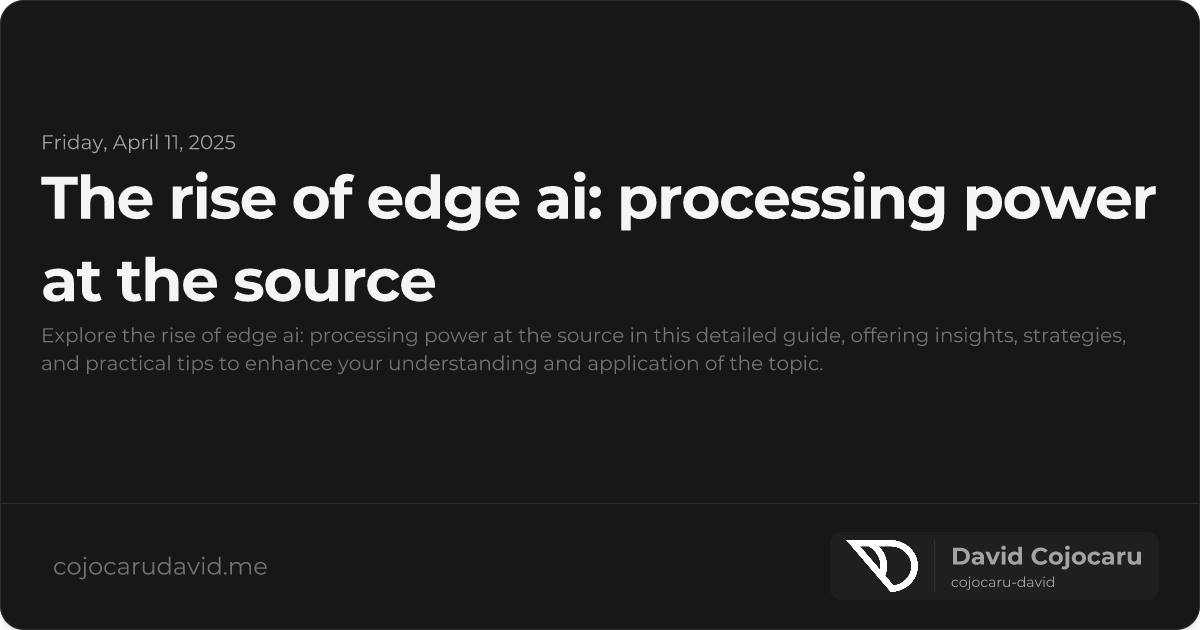Unleashing Intelligence at the Edge: The Power of Edge AI
Forget sending everything to the cloud. Edge AI is revolutionizing how we process data, bringing artificial intelligence closer to the source – right to your devices. Imagine faster response times, greater privacy, and reliable performance, even without a constant internet connection. This is the promise of Edge AI, and it’s transforming industries from healthcare to autonomous vehicles.
What Exactly Is Edge AI?
Edge AI is the deployment of AI algorithms directly onto local devices, like smartphones, security cameras, or industrial sensors. Instead of transmitting data to a centralized cloud server for processing, the AI happens on the device itself. This on-site processing differentiates it from traditional cloud-based AI. Think of it as having a mini AI supercomputer built into everyday objects.
Key Advantages of Edge AI:
- Blazing Fast Speed (Low Latency): Real-time insights and immediate actions, eliminating delays caused by network communication.
- Bandwidth Savings & Reduced Costs: Dramatically reduces the amount of data transmitted, saving on bandwidth consumption and associated expenses.
- Unbreakable Privacy: Keeps sensitive data secure by processing it locally, minimizing the risk of exposure during transmission.
- Always-On Functionality (Offline Capabilities): Continues to operate effectively even without a stable internet connection, ensuring consistent performance.
Why Edge AI Is Exploding in Popularity
The growing need for real-time insights, automated systems, and increased privacy is fueling the rapid adoption of Edge AI. Industries are eager to leverage its benefits for enhanced efficiency, safety, and customer experiences.
Real-World Edge AI Applications:
- Healthcare: Wearable devices providing instant analysis of vital signs for proactive health monitoring.
- Manufacturing: On-site sensors enabling predictive maintenance, reducing downtime, and improving operational efficiency.
- Retail: In-store AI delivering personalized shopping experiences, optimizing product placement, and preventing theft.
- Autonomous Vehicles: Enabling instantaneous decision-making for safer navigation and collision avoidance.
- Smart Homes: Intelligent thermostats, security systems, and appliances that learn and adapt to user preferences without sending data to the cloud.
How Edge AI Works: A Simplified Explanation
Edge AI relies on a combination of optimized machine learning models and efficient hardware. The process typically involves:
Edge AI Deployment in 4 Steps:
- Cloud-Based Model Training: Complex AI models are initially trained using vast datasets in the cloud.
- Model Optimization & Compression: Trained models are then optimized and compressed (often using frameworks like TensorFlow Lite or TinyML) to make them small enough to run on resource-constrained edge devices.
- Edge Device Deployment: The optimized AI model is then deployed and embedded into the target hardware.
- On-Device Inference: The edge device processes real-time data using the embedded AI model, generating insights and taking actions locally.
Challenges and Future Directions for Edge AI
Despite its incredible potential, Edge AI faces challenges. The limited processing power and memory available on edge devices can restrict the complexity of AI models. However, ongoing innovations are addressing these limitations.
Exciting Trends Shaping the Future of Edge AI:
- 5G Connectivity: Enables faster and more reliable data synchronization between edge devices and the cloud, improving model updates and overall system performance.
- Specialized AI Chips: The development of dedicated AI chips specifically designed for edge computing, offering enhanced processing power and energy efficiency.
- Federated Learning: A revolutionary approach allowing AI models to be trained collaboratively across multiple edge devices without sharing raw data, further enhancing privacy.
The Future is Decentralized: Embrace the Edge
Edge AI is transforming the technological landscape, bringing intelligence to the very devices we rely on daily. By decreasing our reliance on the cloud, Edge AI empowers us with greater speed, enhanced security, and improved scalability, ushering in a new era of decentralized computing where the power of AI is in our hands.
“Edge AI represents more than just a technological leap; it signifies a fundamental shift, empowering devices and their users with unprecedented control and capabilities.”

